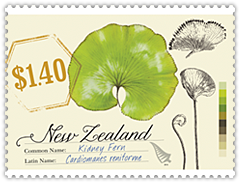On the 7th February New Zealand issued a set of five stamps depicting native ferns.
New Zealand's climate is just right for the many types of fern found in our native forests. I live in a country area myself and the bottom half of my property has been allowed to return to native bush. First the gorse and scrub reclaimed the once cleared land, then larger trees like manuka began to appear. These larger trees killed off the scrub underneath making way for many other native species including our native ferns. I was down there today and in some places the ferns are now so thick it impossible to walk through.
The Stamps
I like the design of these stamps. They have a pleasant appearance, are simple, well laid out and not cluttered. The fern is depicted in bold coloured diagrams with other detail drawings in grey. The ferns common and scientific names appear under 'New Zealand' and the demonization appears as a symbolic post mark. Nice design, well done.
The Colenso's Hard Fern off the $1.90. is another wet area fern. It is usually found on shaded banks or shaded areas around streams and waterfalls. It is recognised by its solid leaves on each frond. The $2.40 stamp depicts the Umbrella Fern. One look at it tells you how it got its name as a fronds appear like the ribs of an umbrella. The Māori name, tapuwae kōtuku means 'the footprint of the white heron' since before the Europeans arrived they had never seen an umbrella.
New Zealand's climate is just right for the many types of fern found in our native forests. I live in a country area myself and the bottom half of my property has been allowed to return to native bush. First the gorse and scrub reclaimed the once cleared land, then larger trees like manuka began to appear. These larger trees killed off the scrub underneath making way for many other native species including our native ferns. I was down there today and in some places the ferns are now so thick it impossible to walk through.
The Stamps
I like the design of these stamps. They have a pleasant appearance, are simple, well laid out and not cluttered. The fern is depicted in bold coloured diagrams with other detail drawings in grey. The ferns common and scientific names appear under 'New Zealand' and the demonization appears as a symbolic post mark. Nice design, well done.
Hen & Chickens Fern. Kidney Fern.
(Asplenium bulbiferum) (Cardiomanes reniforme)
The first fern featured on the 70c is the Hen & Chicken Fern. This is a larger fern found in wetter areas through most of New Zealand. The Kidney Fern on the $1.40 stamp has the appearance of almost a large leaf rather than a fern frond.
Colenso's Hard Fern. Umbrella Fern.
(Blechnum colensoi) (Sticherus cunninghamii)
Silver Fern.
(Cyathea dealbata)
Here it is, the most famous fern of New Zealand and a emblem of country, the Silver Fern. The fronds have a light to deep green on their upper side but are silver underneath. When I take visitors to New Zealand into the bush, I enjoy finding one and turning the frond over to reveal the silver underneath. They are always impressed to see such a famous icon of New Zealand.
You might have noticed that the silver fern was also featured in my Matariki collection. This stamp (see below) has such a good example of a unfolding frond that I decided to include here. All the stamps above show a version of the koru for each fern featured. It is one of the ways the plant can be identified as a fern.
This shape known as the Koru is very important to the Maori people. It is found in caving and tattoos was well as in many other aspects of Maori culture. The design is also used by the national airline, Air New Zealand on the tail of their aircraft.
First Day Cover with Stamps.
First Day Cover with Miniature Sheet.
Technical information
Date of issue:
| 7 February 2013 |
|---|---|
Number of stamps:
| Five gummed stamps |
Stamps, miniature sheet, first day covers and presentation pack designed by:
| 2Di4 Design, Wellington, New Zealand |
Denominations:
| 70c, $1.40, $1.90, $2.40 and $2.90 |
Printer and process:
| Cartor Security Printing, France by offset lithography |
Number of colours:
| Four process colours |
Stamp size and format:
| 40mm x 30mm (horizontal) |
Paper type:
| 102gsm red phosphor gummed stamp paper |
Number of stamps per sheet:
| 25 |
Perforation gauge:
| 13.25 x 13 |
Period of sale:
| These stamps remained on sale until 6 February 2014. |








We appreciate your engagement with our content. To ensure a respectful and constructive community, please take note of the following:
- No Spam, Please: We do not tolerate spammy or promotional comments. Any such comments will be promptly removed.
- Moderation in Place: All comments are moderated to maintain a positive and inclusive environment. Please be patient, as it may take a little time for your comment to appear.
- Sign In with Google: To comment, please sign in using your Google account. This helps us maintain the integrity of our community and allows for better interaction.